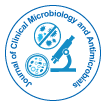
Journal of Clinical Microbiology and Antimicrobials
Open Access
+44-77-2385-9429

+44-77-2385-9429
Perspective - (2024)Volume 8, Issue 3
Antimicrobial Peptides (AMPs) are small proteins that form an essential part of the innate immune system across a wide variety of organisms, from plants to humans. These peptides serve as natural antibiotics, providing the first line of defense against infections caused by bacteria, fungi, viruses and parasites. As Antimicrobial Resistance (AMR) continues to rise, there is growing interest in AMPs as potential therapeutic agents that could complement or replace traditional antibiotics. This study analyzes the structure, mechanisms and therapeutic potential of AMPs, alongside the challenges and opportunities for their clinical application.
Structure and classification of antimicrobial peptides
AMPs are typically composed of 12 to 50 amino acids and are characterized by their positive charge, amphipathicity (having both hydrophobic and hydrophilic regions) and ability to form secondary structures such as α-helices or β-sheets. Their cationic nature enables them to interact with the negatively charged surfaces of microbial membranes, facilitating their antimicrobial activity. AMPs can be classified into different categories based on their structure, function and origin.
Cationic peptides: These peptides carry a positive charge, enabling them to bind to the negatively charged microbial membranes.
Anionic peptides: These peptides have a negative charge and target specific bacterial cell wall components.
β-sheet peptides: These peptides are characterized by a β-sheet structure and typically act against both Gram-positive and Gramnegative bacteria.
α-helical peptides: These peptides adopt an α-helix shape in the membrane, disrupting microbial cell integrity.
Mechanisms of action
The antimicrobial activity of AMPs primarily involves disrupting the integrity of microbial cell membranes, leading to cell death.
The mechanisms of action can be broadly divided into the following:
Membrane disruption: AMPs interact with the microbial membrane, causing pore formation or complete membrane destabilization. The cationic peptides bind to the anionic lipids in bacterial membranes, creating transient pores that result in the leakage of intracellular contents and eventual cell death. This is particularly effective against Gram-negative bacteria with their outer membrane.
Intracellular targeting: Some AMPs are capable of entering microbial cells and interacting with intracellular targets, such as DNA, RNA or proteins. These peptides can disrupt DNA replication or protein synthesis, leading to cell death.
Immune modulation: AMPs can also modulate the immune response by recruiting immune cells to the site of infection. They can stimulate the release of cytokines and other immune molecules, enhancing the host's ability to fight infections.
Immune modulation:
Therapeutic potential and applications
As antibiotic resistance becomes an increasingly urgent public health issue, AMPs have gained attention for their potential as alternative therapeutic agents. The ability of AMPs to target and disrupt microbial membranes, often through mechanisms different from traditional antibiotics, makes them less likely to face the same resistance pathways. AMPs have shown activity against both Gram-positive and Gram-negative bacteria, including multidrug-resistant strains such as Methicillin- Resistant Staphylococcus Aureus (MRSA), Vancomycin-Resistant Enterococci (VRE), and Extended-Spectrum Beta-Lactamase (ESBL)-producing bacteria. Several AMPs, such as polymyxins and colistin, are already in clinical use for multidrug-resistant infections. In addition to bacterial infections, AMPs have shown activity against fungi and viruses. For instance, human cathelicidin LL-37 has been found to be effective against Candida albicans and Herpes Simplex Virus (HSV). AMPs have been shown to promote wound healing by stimulating cell migration, angiogenesis and reducing inflammation. This has led to their use in topical treatments for chronic wounds and burns. Some AMPs exhibit anticancer activity by disrupting tumor cell membranes or modulating immune responses. Research is underway to analyze the use of AMPs as adjuvants to traditional cancer therapies. AMPs are being investigated as part of combination therapy to enhance the effectiveness of existing antibiotics. By disrupting biofilms and increasing the permeability of bacterial membranes, AMPs can potentially make bacteria more susceptible to conventional drugs. Antimicrobial peptides are a potential class of compounds with significant therapeutic potential in the fight against microbial infections. Their broad-spectrum activity, immune-modulating effects and potential to combat antibiotic-resistant pathogens make them a valuable addition to the antimicrobial arsenal. While challenges remain, ongoing research is focused on overcoming the limitations of toxicity, production costs and resistance development. With continued advancements, AMPs may become an essential component of future infection management strategies, providing an important tool in the battle against the growing threat of antimicrobial resistance.
Citation: Shingo K (2024). Antimicrobial Peptides: Natural Defenders in the Fight Against Infection. J Clin Microbiol Antimicrob. 8: 200.
Received: 23-Aug-2024, Manuscript No. JCMA-24-35602; Editor assigned: 26-Aug-2024, Pre QC No. JCMA-24-35602 (PQ); Reviewed: 09-Sep-2024, QC No. JCMA-24-35602; Revised: 16-Sep-2024, Manuscript No. JCMA-24-35602 (R); Published: 23-Sep-2024 , DOI: 10.35248/ JCMA. 24.8.200
Copyright: © 2024 Shingo K. This is an open-access article distributed under the terms of the Creative Commons Attribution License, which permits unrestricted use, distribution, and reproduction in any medium, provided the original author and source are credited.